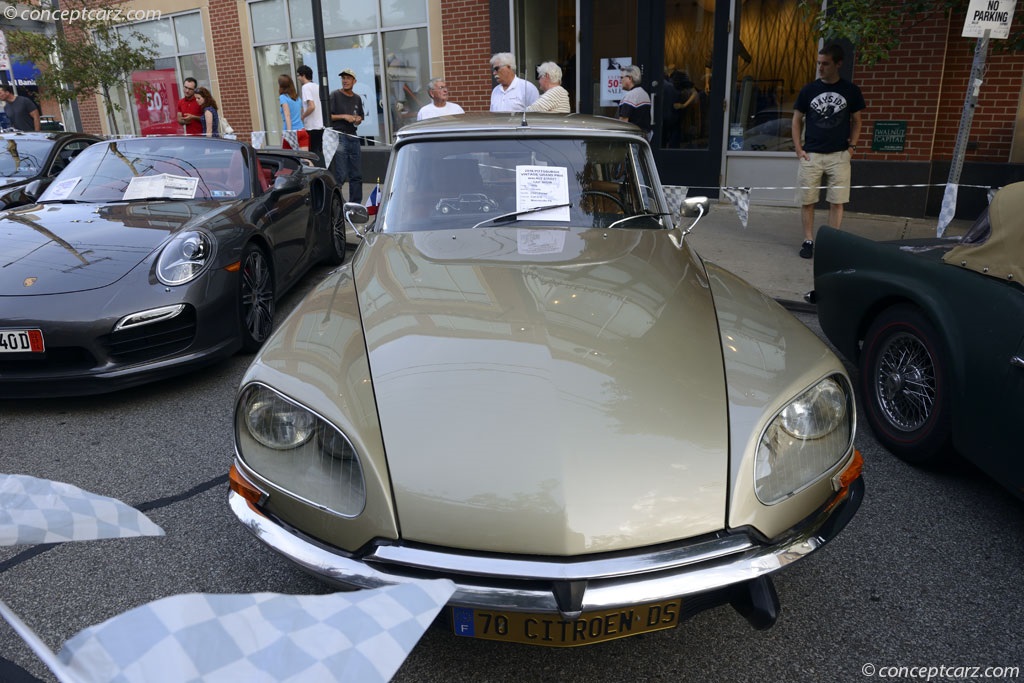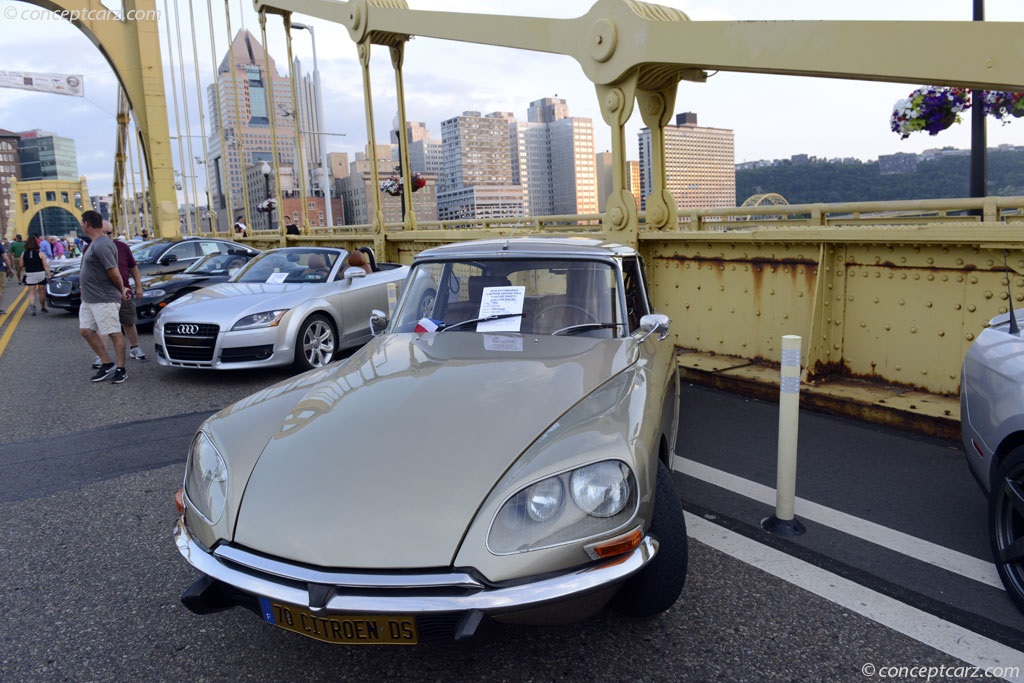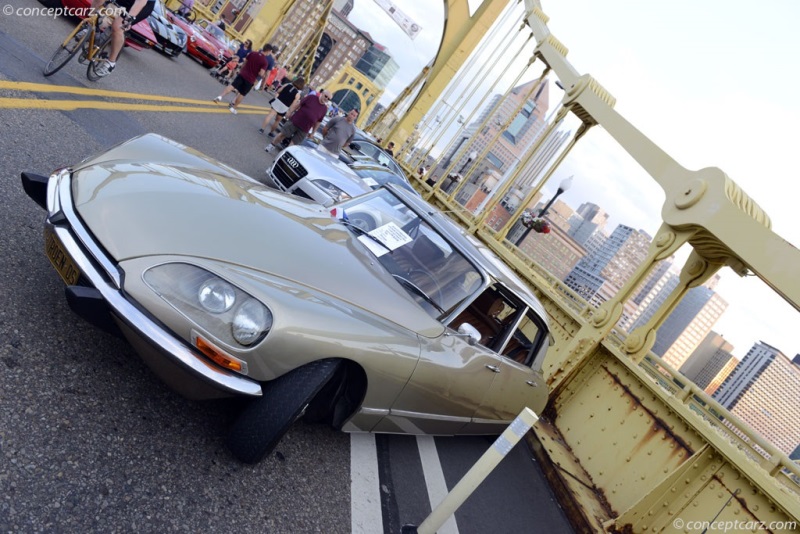Citroen introduced its DS model in October of 1955 at the Paris Motor Show with Avant grade styling courtesy of Flaminio Bertoni and endowed with cutting-edge technology, particularly its self-leveling hydropneumatic suspension. The well-received and popular DS remained in production through 1975 across three series in wagon/estate, convertible, and sedan/fastback configurations. Over 1,455,700 examples were built in six countries, of which 1,330,755 were manufactured at Citroen's main Paris Quai de Javel production facility. Along with its less expensive variant, the Citroen ID, the DS wore an aerodynamic and non-conventional body design influenced by the Space Age era. While the world was often reluctant to embrace the non-traditional option (i.e. the Chrysler / DeSoto Airflow of the 1930s), the Citroen DS proved very popular with over 12,000 orders placed during the first day of the Paris Salon. By the time the Grand Palais closed its doors a week later, that number had risen to 80,000. To many, the DS symbolized French ingenuity during a time when the country was still wrestling with the devastation caused by World War II. Its unusual design was complemented by its adoption of non-traditional configurations and technology, including front-engine layout, disc brakes, a semi-automatic transmission, and centerlock wheels. A US manufacturer named Crosley had produced vehicles with disc brakes, but it was the Citroen DS that was the first successful application of this technology on a mass-produced production automobile. Shifting of the semi-automatic (Hydraulique four-speed semi-automatic) transmission was still done by hand, but it required no clutch pedal. In place of a mechanical linkage, the shift lever was controlled by a powered hydraulic shift mechanism. The center-lock wheels allowed for rapid wheel changes in the event of a puncture, as they were affixed via an Allen bolt acting as the central fastener and a hexagonal protrusion transferred drive to a recess in the wheel. Hydraulic power was used for the brakes, power steering, clutch, transmission, and self-leveling suspension system. The less-expensive ID19 had manual steering and a less complicated power braking system. The hydropneumatic suspension system connected each wheel independently with a hydraulic accumulator sphere containing pressurized nitrogen, a cylinder containing hydraulic fluid, a piston inside the cylinder, and a damper valve between the sphere and piston. The cylinder was attached to the suspension sphere and the piston was connected by levers to the suspension. A valved controlled by the mid-position of the anti-roll bar connected to the axle fed the hydraulic cylinder with hydraulic fluid. Fluid was either added or released depending on suspension height, thus maintaining a constant ride height. The driver was able to select one of five heights from a control in the cabin, raising or lowering the vehicle. Thus, the vehicle was suitable for a variety of road conditions, terrains, and even flat tires, and had no need for a jack to raise the car off the ground. To remove the flat tire, the suspension would be raised to its highest setting, a stand would be inserted into a special peg near the flat tire, then adjust the suspension to its lowest setting. The flat tire would remain above the ground while the rest of the wheels lowered. Nearly every aspect of the DS was advanced and futuristic, but under the bonnet was an overhead-valve four-cylinder unit derived from the 11CV Traction Avant.
An air-cooled flat-six based on the design of the 2-cylinder engine of the 2CV was initially considered but abandoned due to technical and monetary issues. The four-cylinder engine had three main bearings, wet liners, a bore and stroke of 3.1- and 3.9-inches respectively, an aluminum cross-flow head with hemispherical combustion chambers, and a displacement of 1,911cc. While the 11C had developed 60 horsepower, the DS 19 offered 75 hp at 4,500 RPM. Both the Traction Avant and the DS had the transmission at the front, followed by the differential, and then the engine. This allowed the engine to be positioned far back in the engine bay, resulting in a 'mid-front' configuration. Smaller engines were encouraged by the tax horsepower system imposed on French cars, and although it was underpowered, its lower costs aided in its popularity. In 1965, the 1911cc three main bearing engine was replaced with a 1985cc five-bearing wet-cylinder unit, resulting in a name change to the DS 19a (from September of 1969 forward, they were called the DS 20). The DS 21 arrived in 1976 with a 2,175cc, five main bearing engine that offered 109 horsepower. In 1970, horsepower increased further with the introduction of Bosch electronic fuel injection. Larger inlet valves allowed the carbureted versions to increase slightly in power as well.A three-speed fully-automatic Borg-Warner 35 transmission became available in September of 1971 on the DS 21 and forthcoming DS 23 models. This fully automatic transmission was never sold on DS models destined for the U.S.The final increase in displacement arrived in 1973, now measuring 2,347cc in the DS 23 offered in both fuel-injected and carbureted configuration. The electronic fuel injection DS 23 was capable of producing 141 horsepower, the most powerful production variant of the DS. The DS was joined in 1970 by an entirely new vehicle named the SM which was essentially a modernized version of the DS. The narrow-cabin shortcomings of the DS were displaced by the greater width of the SM, and many of the DS components were either retained or modified. Mounted beneath the bonnet was an exotic (and costly) Maserati engine that helped propel the SM into the luxury car segment. The higher price of the SM meant it was more exclusive than the DS. A more affordable, and smaller version dubbed the CX seized the mantle from the DS and remained in production from 1974 to 1991.
by Daniel Vaughan | Dec 2021
An air-cooled flat-six based on the design of the 2-cylinder engine of the 2CV was initially considered but abandoned due to technical and monetary issues. The four-cylinder engine had three main bearings, wet liners, a bore and stroke of 3.1- and 3.9-inches respectively, an aluminum cross-flow head with hemispherical combustion chambers, and a displacement of 1,911cc. While the 11C had developed 60 horsepower, the DS 19 offered 75 hp at 4,500 RPM. Both the Traction Avant and the DS had the transmission at the front, followed by the differential, and then the engine. This allowed the engine to be positioned far back in the engine bay, resulting in a 'mid-front' configuration. Smaller engines were encouraged by the tax horsepower system imposed on French cars, and although it was underpowered, its lower costs aided in its popularity. In 1965, the 1911cc three main bearing engine was replaced with a 1985cc five-bearing wet-cylinder unit, resulting in a name change to the DS 19a (from September of 1969 forward, they were called the DS 20). The DS 21 arrived in 1976 with a 2,175cc, five main bearing engine that offered 109 horsepower. In 1970, horsepower increased further with the introduction of Bosch electronic fuel injection. Larger inlet valves allowed the carbureted versions to increase slightly in power as well.A three-speed fully-automatic Borg-Warner 35 transmission became available in September of 1971 on the DS 21 and forthcoming DS 23 models. This fully automatic transmission was never sold on DS models destined for the U.S.The final increase in displacement arrived in 1973, now measuring 2,347cc in the DS 23 offered in both fuel-injected and carbureted configuration. The electronic fuel injection DS 23 was capable of producing 141 horsepower, the most powerful production variant of the DS. The DS was joined in 1970 by an entirely new vehicle named the SM which was essentially a modernized version of the DS. The narrow-cabin shortcomings of the DS were displaced by the greater width of the SM, and many of the DS components were either retained or modified. Mounted beneath the bonnet was an exotic (and costly) Maserati engine that helped propel the SM into the luxury car segment. The higher price of the SM meant it was more exclusive than the DS. A more affordable, and smaller version dubbed the CX seized the mantle from the DS and remained in production from 1974 to 1991.
by Daniel Vaughan | Dec 2021
Related Reading : Citroen DS History
Andre Citroen founded the Citroen Company in 1919 and by the late 1920s, it had become Europes largest car manufacturer. They earned a reputation for their build quality, revolutionary engineering, and innovation. The Citroen Traction Avant of the mid-1930s pioneered mass production, unitary body construction with no separate chassis, front-wheel drive, and a four-wheel independent suspension setup.....
Continue Reading >>
Continue Reading >>
Related Reading : Citroen DS History
An executive vehicle, the Citroen DS was also called the Goddess or Déesse and was introduced by the French Manufacturer Citroen. Unveiled in 1955, the Citroen DS was produced until 1975. More than 1.5 million D-series were produced during its 20 year long production run. The D-series was incredibly futuristic and cutting-edge with an aerodynamic body design that was designed by Flaminio Bertoni.....
Continue Reading >>
Continue Reading >>
Similarly Sized Vehicles
from 1970
Similarly Priced Vehicles
AMC AMX ($4,000-$4,000)
Plymouth Road Runner ($2,900-$4,300)
AMC Javelin ($2,725-$4,000)
Dodge Challenger ($2,720-$4,055)
Pontiac Firebird Trans Am ($4,305-$4,305)
Lotus Europa ($4,295-$4,295)
BMW 2000 ($4,140-$4,140)
Plymouth Fury ($2,790-$4,215)
AMC Ambassador ($3,020-$4,120)
Average Auction Sale: $111,129
Plymouth Road Runner ($2,900-$4,300)
AMC Javelin ($2,725-$4,000)
Dodge Challenger ($2,720-$4,055)
Pontiac Firebird Trans Am ($4,305-$4,305)
Lotus Europa ($4,295-$4,295)
BMW 2000 ($4,140-$4,140)
Plymouth Fury ($2,790-$4,215)
AMC Ambassador ($3,020-$4,120)
Average Auction Sale: $111,129
1970 Citroen DS Vehicle Profiles
Recent Vehicle Additions
Performance and Specification Comparison
Price Comparison
$11,700
DS Specification Comparison by Year
Year
Production
Wheelbase
Engine
Prices
4 cyl., 143.22 CID., 141.00hp
Related Automotive News

DS Automobiles Celebrates The SM's Jubilee At Retromobile
In automotive circles, the epitome of majestic grand touring cars is the SM, celebrating its fiftieth anniversary in 2020. Attractive and magnificent, the SM was a major example of collaboration between iconic French and Italian manufacturers.
In...
Citroën Celebrates 100 Years Of Iconic Cars At The London Classic Car Show
Citroën will showcase some of its most iconic vehicles at this years London Classic Car Show to mark its centenary. The show runs from 14 - 17 February at ExCel London and will feature a selection of Citroën vehicles that have made a significant impression...

The powerhouse of the 124 model series: A highly sought-after young classic: the Mercedes-Benz 500 E
Anyone in the know will already be slavering at this model designation launched in 1990, 25 years ago, the Mercedes-Benz 500 E with V8 engine and subtly muscular body is the top-of-the-range model in the 124 model series - and has long been one of the...

Glamorous and Rare Mercedes-Benz at Russo and Steele Newport Beach!
Scottsdale, Arizona (March 26, 2015) – Today, few classic cars are as sophisticated as the W111-generation Mercedes-Benz 280SE 3.5 Cabriolet. Rare and highly refined, these athletic and luxurious five-passenger automobiles continued the enviable...
Enhanced Kia Venga to be revealed at Paris Show
Refreshed look for upgraded 2015 Kia Venga on cars fifth anniversary
Compact MPV has a new face and more sophisticated cabin
New options include integrated 7.0-inch navigation display screen
Enhanced Venga on sale in Europe from early 2015
Fr...
























